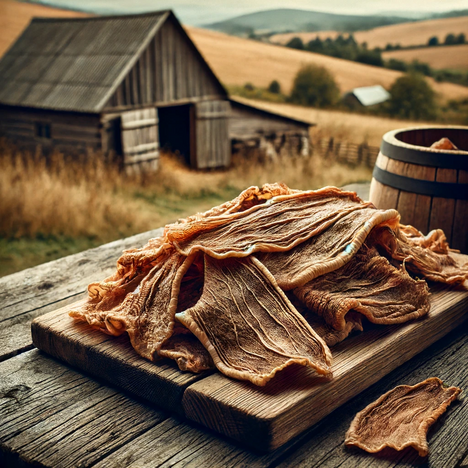Sheepskin

In the world of dog snacks, natural options are increasingly in demand as they not only offer a healthy alternative to conventional treats, but also satisfy dogs' need to chew. Among these natural options, sheepskin has recently gained popularity. But what exactly is sheepskin, and what are the benefits and potential drawbacks for our four-legged friends? This article dives deep into the topic of sheepskin to provide dog owners with a comprehensive perspective.
What is sheepskin?
Sheepskin is exactly what the name suggests: the skin of sheep that is collected after slaughter, cleaned and often dried to serve as a chew for dogs. It is considered a natural, unprocessed alternative to many commercial dog snacks and can come in a variety of forms, from small pieces to large flaps of skin.
Benefits of sheepskin for dogs
Using sheepskin as a dog snack offers a number of benefits that make it an attractive option for many dog owners.
- Natural chewing pleasure: Sheepskin provides a safe and natural way for dogs to satisfy their need to chew, which can help reduce boredom and prevent destructive chewing behavior.
- Teeth cleaning: Chewing on sheepskin can help reduce plaque and tartar, supporting a dog's oral hygiene.
- Healthy ingredients: Compared to some processed snacks, sheepskin contains no artificial additives or fillers, making it a healthier option.
- Source of protein: Sheepskin is rich in protein, making it a nutrient-rich snack that can contribute to muscle health.
Disadvantages and risks
Despite the benefits, there are also some concerns and risks associated with feeding sheepskin to dogs that should be considered.
- Choking hazard: Large pieces of sheepskin can pose a choking risk, especially for small dogs or dogs that tend to gulp their food.
- Digestive problems: Some dogs may be sensitive to sheepskin, which can lead to gastrointestinal discomfort.
- Differences in quality: The quality of sheepskin can vary, depending on the source and processing method. Poorly processed sheepskin may contain harmful substances or have been treated with chemicals.
- Overfeeding: As with any treat or snack, overfeeding sheepskin can lead to weight gain and associated health problems.
Guidelines for the use of sheepskin
To maximize the benefits of sheepskin and minimize the risks, dog owners should adhere to the following guidelines:
- Supervision: Supervise your dog when chewing sheepskin to ensure no pieces are swallowed that could pose a choking risk.
- Quality control: Choose high quality sheepskin, ideally from trusted producers who use natural processing methods.
- Moderation: Feed sheepskin in moderation to avoid overfeeding and weight problems.
- Introduction: Introduce sheepskin slowly into your dog's diet to ensure no adverse reactions occur.
A balance between chewing pleasure and caution
Sheepskin can be a valuable addition to your dog's diet and chewing behavior, provided it is used responsibly and judiciously. The natural benefits, such as helping to clean teeth and providing a healthy source of protein, make sheepskin an attractive snack. However, it is important not to ignore potential risks such as choking hazards and digestive issues and to always prioritize quality and moderation. Ultimately, it is up to the dog owner to weigh up and decide whether sheepskin is the right snack for their four-legged friend, always with the dog's welfare in mind.
If you notice any signs of hypersensitivity or poisoning in your dog, you should see your vet immediately. We are not a substitute for a vet, but we try to be as accurate as possible. Every dog reacts differently and we recommend you get a second opinion or consult your vet if in doubt.
Stay healthy and take good care of your four-legged friend!😊